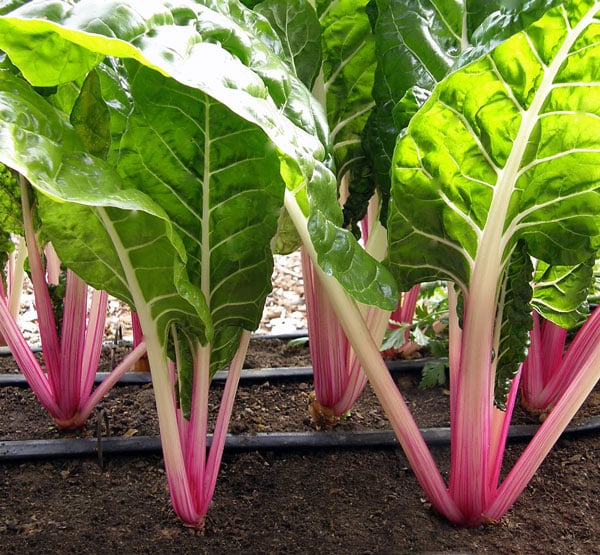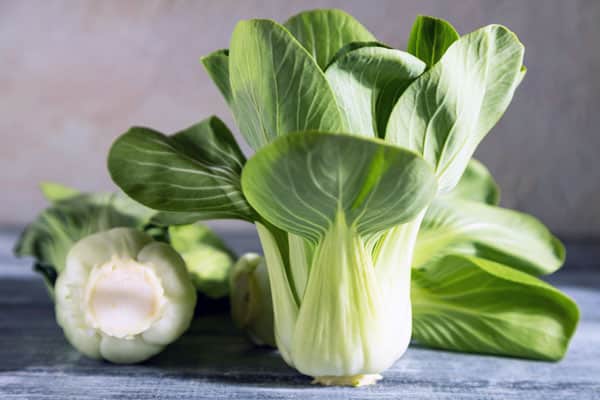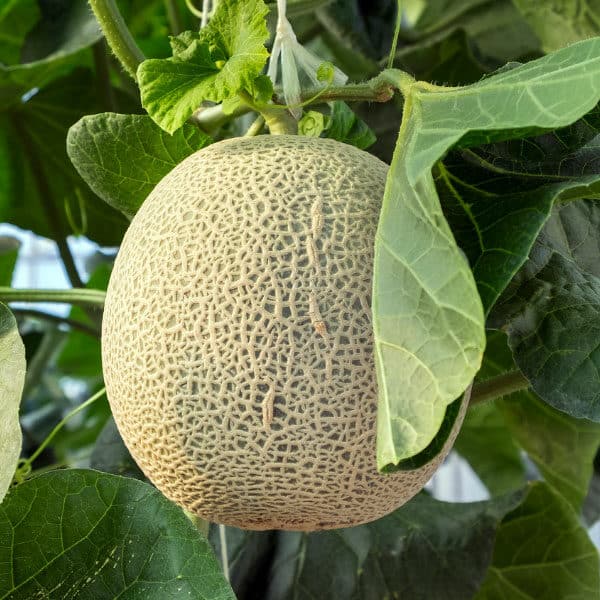This post may include affiliate links.
If you make a purchase, I'll earn a small fee at no extra cost to you.
Vegetable leaves that are covered in tiny holes usually means a flea beetle infestation. These insect pests feed on a variety of vegetable plants, causing damage and potentially spreading disease. Here are 8 ways to eliminate flea beetles naturally.
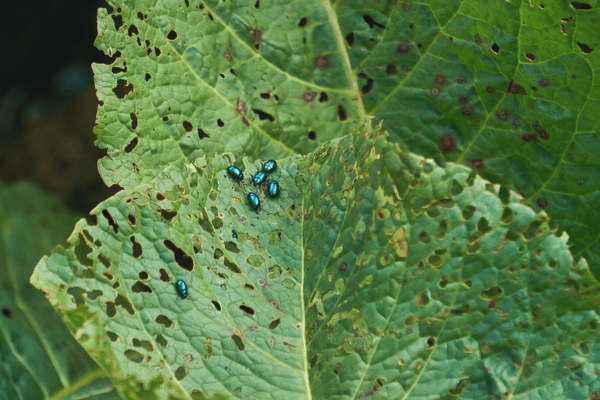
What are Flea Beetles?
Flea beetles are small, shiny-coated beetles that are pretty small – only up to 1/8 inch long. There are a number of flea beetle species, and they can be black, blue, brown, or gray; multicolored, striped, or spotted. These insects have large back legs which give them the ability to jump quite well – especially when startled. That funny jumping habit is how they got the name “flea” beetle.
Are Flea Beetles Harmful to Humans or Pets?
Contrary to their name, flea beetles only chew on foliage. They won’t bother pets or humans at all.
What Does Flea Beetle Damage Look Like?
Most people will notice flea beetle damage in the form of small random holes in the leaves of a plant. On new leaves, this damage looks like a lacy pattern. The exception is the corn flea beetle which chews straight lines into corn leaves.
In established plants, these insect pests won’t cause much harm (except in leafy greens where the leaves are what you’re harvesting). In small plants, this damage can cause wilting and may even kill young plants.
The bigger danger is that flea beetles can spread bacterial diseases like wilt and blight. So even if you have a small infestation on established plants, it’s a good idea to get rid of those flea beetles before they cause real trouble.
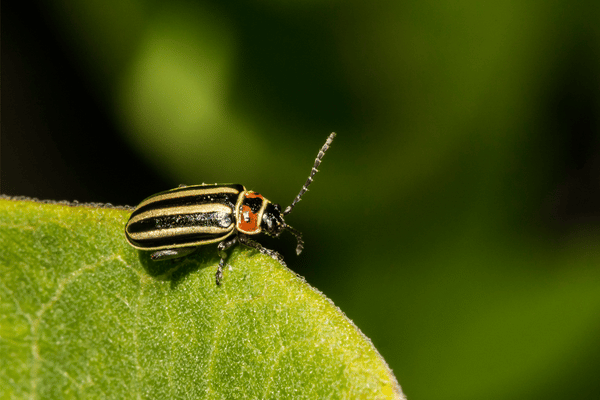
What do Flea Beetles Eat?
For the most part, flea beetles just want to munch on the green leaves in your garden. But different flea beetle species are attracted to different plants. Make sure to check the leaves of all your plants for flea beetle damage. Here are the plants they’re most likely to target:
- Tomatoes
- Beans
- Peppers
- Potatoes
- Radishes
- Turnips
- Broccoli
- Spinach
- Melons
- Eggplant
- Cabbage
The Flea Beetle Life Cycle
It’s always handy to know the life cycle of garden pests so you can understand how to prevent an infestation or get rid of one when it’s already started. Here’s the life cycle of the flea beetle:
Eggs
Adults lay eggs in the soil at the base of plants as soon as it gets warm in the spring. Because they’re in the soil, flea beetle eggs are hard to detect. These eggs will hatch in about 7-14 days.
Larvae
When the eggs hatch, small white larvae emerge. These will feed mostly on the plant roots of seedlings and young plants. Flea beetle larvae mostly stay underground, so it’s not likely you’ll notice them at this stage (though you might notice some of your seedlings wilting).
Pupae
Once fully grown, the larvae pupate in the soil for 10-14 days. Again, you won’t notice them at this time. They also don’t cause damage to plants at this stage.
Adults
Adults emerge from the soil and start feeding on host plants right away. Adult flea beetles are responsible for most of the damage these pests can cause. Adults will also go on to lay more eggs. There can be up to three generations of flea beetles in every growing season!
Adults overwinter in weeds and yard debris. When the weather turns warm, they come out to lay eggs and the cycle starts all over again.
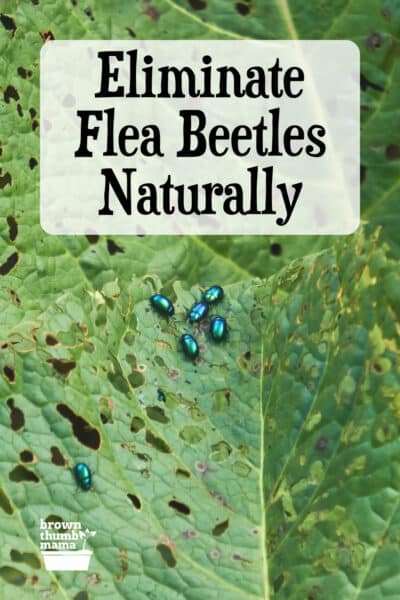
Natural Ways to Get Rid of Flea Beetles
Now it’s time to learn how to get rid of those flea beetles if they become a problem in your garden! I’ll also share some prevention tips that will keep you one step ahead of an infestation.
Sticky Traps
These are yellow or white pieces of cardboard with special adhesive. As flea beetles jump from plant to plant, they land on the trap and are unable to get away. While you can catch some flea beetles with these traps, it’s better to use them in the early spring as a pest detection system. Then use more targeted defenses once you know what pests you are dealing with.
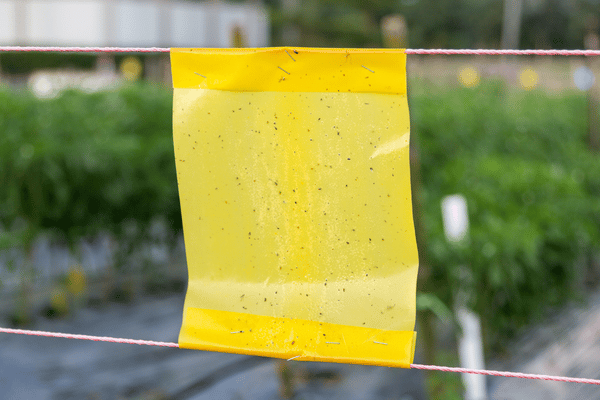
Companion Planting
When you plant aromatic plants near your vegetables, it can confuse and deter flea beetles. Dill, basil, catnip, and mint are excellent companion plants that you can also eat! Marigolds are also a versatile companion plant that deter many pests.
Trap Crops
Trap crops are sacrificial plants that attract insect pests. You plant them early in the season, near your garden or as a border (not mixed in with your vegetables). The flea beetles will attack those plants first, and then you can easily dispatch them before they invade the rest of your garden. Radishes and mustard are good trap crops for flea beetles.
Row Covers
A simple row cover can make a big difference in protecting your leafy greens or plants that don’t need to be pollinated. (Don’t cover plants that need pollination, or you won’t get any fruit!) As an added bonus, row covers also protect young plants from the hot sun, cold nights, and harsh winds.
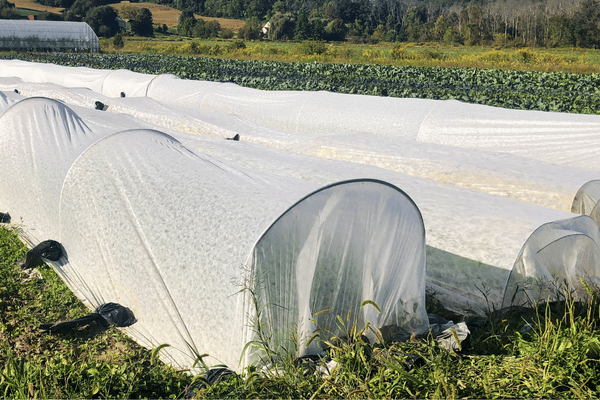
Neem Oil Spray
Because flea beetles primarily feed on leaves, sprays can actually work quite well for repelling these bugs. Neem oil spray is all natural and works especially well because it tastes and smells icky to bugs like flea beetles. You need to spray the leaves thoroughly at least once a week and also after a heavy rain.
If you can repel the adults, you not only prevent leaf damage, but you also drive them away so they’re less likely to lay eggs in your garden and cause future problems. Neem oil spray has gained a lot of popularity, so it’s available in some garden centers or you can purchase it easily online.
Insecticidal Soap
Like neem oil, natural insecticidal soap sprays are very effective at deterring flea beetles. They’re also readily available in garden centers and online. As with the neem spray, you want to spray the leaves with a good coating at least once per week (more if you have a serious flea beetle problem). And remember to give your plants another spray after a heavy rain.
You can also make your own insecticidal soap spray at home. Here’s how:
- Add 1 teaspoon dish soap and 1 teaspoon vegetable oil to a 16-oz spray bottle.
- Fill the rest with plain water (leave enough room at the top to shake the mix together).
- Shake gently and spray on plant leaves as needed.
Diatomaceous Earth
Diatomaceous earth (DE) is a natural white powder that can be very effective at getting rid of flea beetles. It doesn’t work as well on leaves, but you can sprinkle it around the base of your plants, which can prevent adults from laying eggs and also get rid of pesky larvae that will eventually turn into adults. Rain washes away DE, so be sure to reapply after it rains.
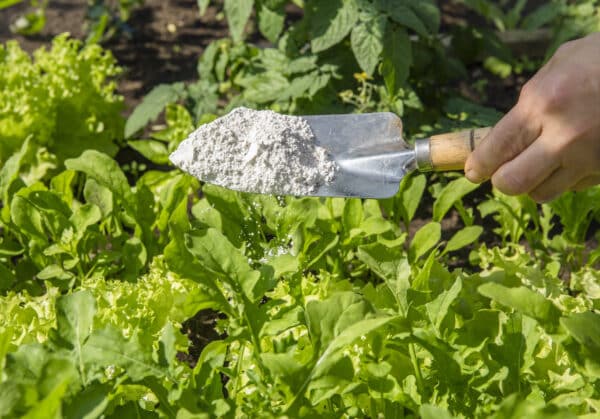
Proper Garden Maintenance
Keeping your garden tilled and free of debris will go along way in preventing flea beetle infestations. Turn the soil over well in late fall and early spring to uncover any adults hiding in your garden. If it’s cold enough, they won’t survive the elements.
Also keep an eye out for plant debris and leaf litter around your garden. These are havens for adult flea beetles who try to overwinter in debris. A clean garden space can stop these pests before they get started.
What About Commercial Insecticide Sprays?
Because flea beetles are primarily on the leaves of plants, insecticides like permethrin can be very effective. I only recommend commercial insecticides as a last resort when an infestation isn’t responding well to natural methods. Just use them long enough to solve the problem and then switch back to natural prevention. Also, avoid spraying your plants for 7-10 days before harvesting.
Did you like this article on how to eliminate flea beetles naturally? Please like and share with your fellow gardening friends!


